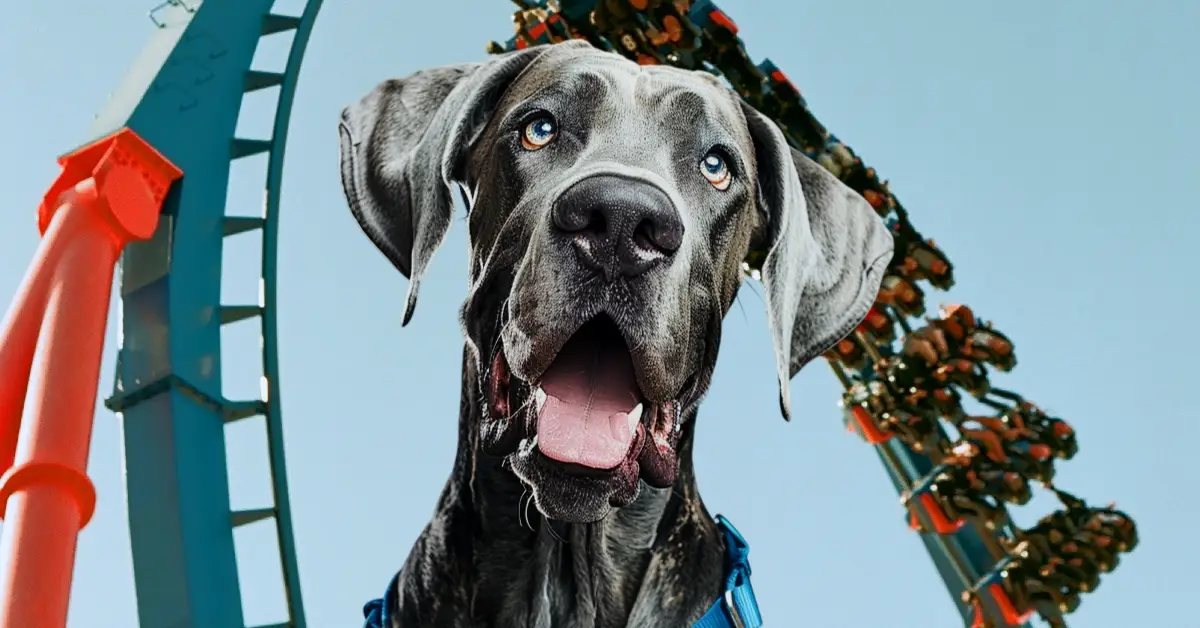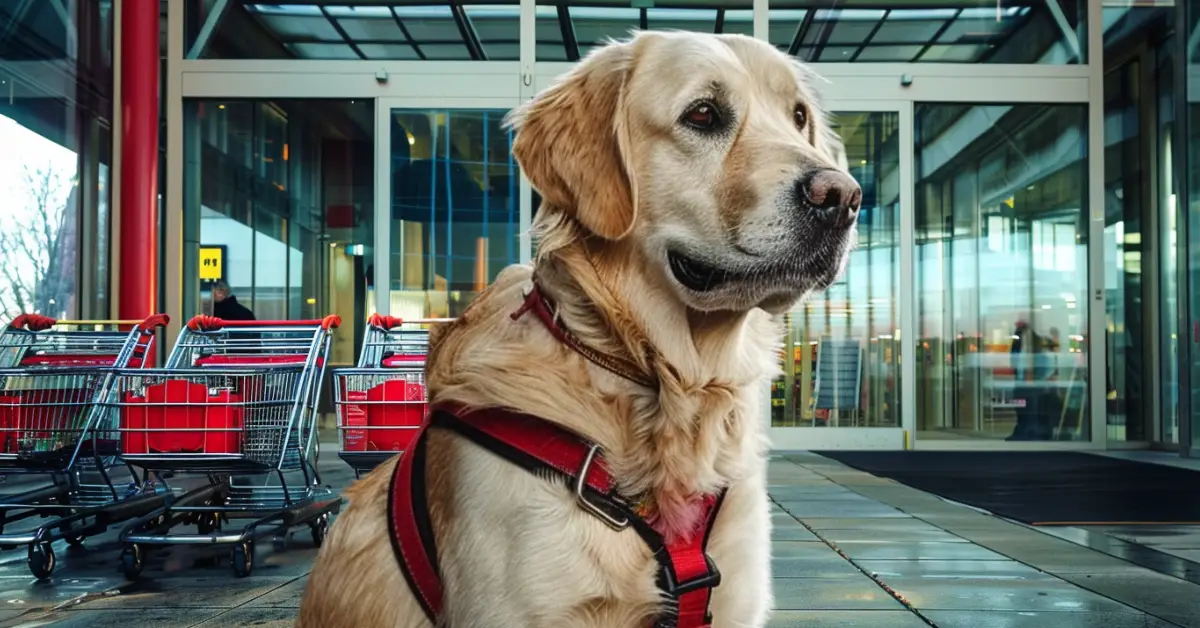Complete Checklist of Stress Signs for Service Dogs

Service dogs are always working to ensure and protect the welfare of their human handler. Therefore, these dogs can experience and accumulate a lot of stress each day. It’s essential for handlers to recognize signs of stress for their service dogs, and to understand ways of preventing and lowering stress for these animals. This allows them to continue performing their tasks and duties under the highest conditions of health and wellness possible. Ensuring and protecting the welfare of service dogs is as important as the work they do for their humans.
Stress Signs for Service Dogs
Since they can’t communicate with words, service dogs exhibit signs of stress through their bodies and behaviors. Here is a list of stress signs to watch for in a service dog:
Eye/Look Indicators
- Avoiding eye contact
- Blinking
- Breaking eye contact
- Dilated eyes
- Frequent looks for direction
- Glazed look
- Looking away
- Quick eye movements
- Red eyes (sign of increased blood pressure)
- Showing whites of eyes (Whale Eye)
- Squinting
- Staring directly
Mouth Indicators
- Air snapping
- Drooling
- Flicking tongue
- Licking lips
- Nose licking
- Panting too wide or shallow breathing
- Showing teeth
- Whiskers pricked forward or slicked back
- Yawning
Head/Ear Indicators
- Burying head
- Ears held up
- Furrowed brow
- Laying ears back
- Quick head movements
- Scowling look
- Turning head away
- Uneven ears
Vocal Indicators
- Barking excessively
- Growling
- Screaming
- Sharp yipping
- Whining
Body Indicators
- Freezing
- Hiding
- Lowered tail (if this is unusual)
- Raised tail (if this is unusual)
- Shaking off
- Stiff posture or walk
- Stretching
- Trembling
- Turning away
Other Indicators
- Bladder problems
- Bowel problems
- Chewing themselves
- Clenching toes
- Digging
- Excessive gas
- Hiding behind human partner
- Injuring self
- Leaning or bumping into human partner
- Lethargy
- Non-response
- Poking or shoving handler repeatedly
- Red pigmentation of skin, ears, or eyes
- Refusal to eat
- Scratching self
- Seeking attention
- Sniffing
- Spinning in circles
- Sweaty or moist paw prints on floor
- Unusually loose stool
- Weight loss
How to Prevent Stress in Service Dogs
It’s essential to prevent stress in the life of any animal as much as possible. This is even more true for service dogs due to the fact that their lives are quite different from their pet dog counterparts.
Relaxation time not only compensates them for their service, but it allows their needs to be prioritized which can help to prevent stress. Relaxation periods should not be paired with working obligations but should be a time of freedom and play. This allows service dogs a much needed and deserved break from not only performing tasks but being at the ready to do so in each moment.
In addition to relaxation time, stress in service dogs can also be prevented through caring for their health and wellness. Since service dogs are committed and devoted to their human handlers, their own level of health and wellness must be excellent in terms of nutrition, veterinary care, grooming, etc. If the comprehensive health needs of service dogs are met, this allows them to perform their duties without the added stresses of feeling unwell physically, mentally, or emotionally.
Exercise is extremely important for the well-being of all dogs, and especially service dogs. Experts recommend at least 30 minutes per day of dedicated exercise for service dogs. Not only does exercise keep service dogs in good health, it also helps to prevent stress from building up throughout each day and over a prolonged period of attentive work.
How to Lower Stress in Service Dogs
There may be times when stress in service dogs in unpreventable and unavoidable. During these times, it’s essential to lower stress in service dogs as much as possible.
If you notice that a particular environment or set of circumstances is causing your service dog to show signs of stress, it’s wise to remove them from the situation if possible. This will give them a chance to regain their calm and focus. If there is a situation in which your service dog repeatedly reacts with stress signals, a different approach to training may be required for them to adjust without feeling anxious.
Do not attempt to comfort your dog if they are stressed. This may reinforce your service dog’s fear and they may react negatively to the stressor in the future. If you must show affection or praise, have your service dog perform a command or task first. Provide affection and praise when a desirable behavior has been displayed.
Some dogs may respond well to fast paced commands or “doodle work” when feeling stressed. The thinking behind this is that issuing quick simple commands can get your dog into a different mindset.
Conclusion
It’s important for handlers to be consistent and frequent in offering reinforcement. Service dogs are highly intuitive to their performance, and they rely on reinforcement from their human partner to understand that they are doing their job effectively. Reinforcement that is inconsistent or withheld can result in confusion, which leads to stress.
Overall, one of the best ways to lower stress in service dogs is for their handlers to cope with and react to stress in as calm a manner as possible. This can be very difficult for people with disabilities. However, service dogs are trained to monitor the slightest mood alterations or levels of stress in their human partners. Persistent, heightened stress on the part of their human handlers can result in persistent, heightened stress in service dogs. This level of stress takes its toll on the dog, their ability to perform tasks, and their overall well-being.
About the Author: The writing team at Service Dog Certifications is made up of folks who really know their stuff when it comes to disability laws and assistance animals. Many of our writers and editors have service dogs themselves and share insights from their own experiences. All of us have a passion for disability rights and animals.
Latest Posts

Can you bring a service dog to a museum?
Yes, you can bring your service dog to the museum! All the major U.S. museums welcome guests with service animals in accordance with the Americans with Disabilities Act (ADA). There are some areas, however, that might be off-limits. Here’s what you should know if you plan to spend a day at the museum with your […]

Read More

How to Bring a Service Dog to Six Flags Magic Mountain
Service dogs are welcome at Six Flags Magic Mountain so long as they are, according to Six Flags, “trained to do work or perform tasks for people with disabilities.” Of course, your dog must be housebroken and remain on a leash or harness and under your control while at the park — and the park […]

Read More

When Stores Can Refuse Your Service Dog
According to the Americans with Disabilities Act (ADA), service dogs should be allowed into any store most of the time. A store owner can legally exclude a service dog if they are actively growling, snapping at, or frightening customers, or if the dog is obviously out of the control of its owner. Ordinary behaviors — […]

Read More